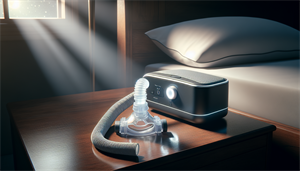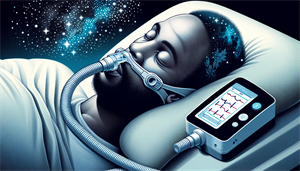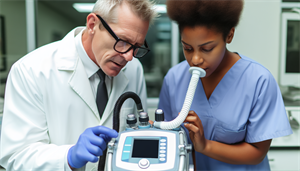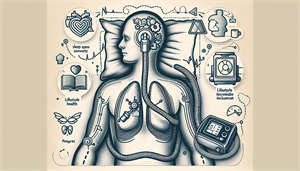Imagine finding relief from the constant interruptions of sleep caused by sleep apnea, finally achieving a good night’s sleep, and waking up refreshed and rejuvenated. This is the promise of Continuous Positive Airway Pressure (CPAP) therapy, a common treatment for obstructive sleep apnea.
However, the effectiveness of this treatment hinges on proper CPAP settings for sleep apnea. Understanding, adjusting, and maintaining these settings is a critical aspect of the treatment journey, and just like any other journey, it starts with a single step - knowledge. Let’s embark on this journey together, shall we?
Key Takeaways
-
CPAP therapy is an essential treatment for obstructive sleep apnea with pressure settings typically ranging from 4 to 20 cmH2O, and choosing the correct pressure setting, machine type, and mask is critical for effective treatment.
-
Determining the ideal CPAP pressure should be done through sleep study titration or APAP titration, and adjustments may be necessary over time due to changes in health, lifestyle, or comfort issues.
-
Regular follow-ups with a healthcare provider and proper maintenance are crucial for the efficacy and longevity of CPAP therapy, ensuring optimized pressure settings and troubleshooting potential issues with mask fit or discomfort.
Understanding CPAP Settings for Sleep Apnea

CPAP therapy, also known as continuous positive airway pressure therapy, is a treatment method that involves the patient breathing air at slightly elevated pressures during sleep. This therapy is often recommended to address obstructive sleep apnea, a condition characterized by repeated interruptions in breathing during sleep due to the collapse of the airway. The pressurized air provided by the CPAP machine helps regulate breathing and maintain an open airway, thus alleviating the sleep disturbances caused by obstructive sleep apnea.
The standard pressure range for CPAP settings typically falls between 6 and 15 cmH2O, measured in centimeters of water. Setting the correct CPAP pressure setting is pivotal for the effective treatment of obstructive sleep apnea and the maintenance of deep sleep. The selection of initial CPAP pressure settings and masks is based on a comprehensive assessment that includes:
-
Machine type
-
Expiratory pressure drop
-
Mask type
-
Necessary pressure settings to effectively reduce apnea events per hour
Positive airway pressure CPAP machines come in various categories, with the majority having a maximum pressure of 20 cmH2O. The pressure settings in auto-adjusting CPAP therapy differ from standard CPAP therapy as it can dynamically adapt the pressure level to the user’s requirements. This flexibility allows for more personalized treatment, making the therapy more comfortable and effective.
In conclusion, comprehending CPAP settings significantly contributes to effective sleep apnea treatment. The pressure settings, the type of CPAP machine, and the mask all play a significant role in the treatment process. Therefore, becoming familiar with these elements is key to better manage sleep apnea.
Types of CPAP Machines
CPAP machines are available in different classifications such as standard, auto-adjusting, and bi-level devices, each designed with unique pressure settings. The choice of CPAP masks plays a significant role in the comfort and effectiveness of the treatment. Let’s examine the different types of machines more closely.
Standard CPAP machines deliver a constant level of pressure throughout the night. This type of machine is suitable for those whose pressure needs stay relatively steady during sleep. On the other hand, auto-adjusting CPAP machines, also known as APAP machines, vary the pressure throughout the night based on the user’s needs. They are designed to incrementally modify the therapeutic pressure to address apnea events as they are identified. This feature makes APAP machines a preferred choice for those who require varying pressure levels throughout the night.
The three types of devices are:
-
Continuous positive airway pressure (CPAP) devices, which provide a constant and steady pressure throughout the breathing cycle.
-
Automatic positive airway pressure (APAP) devices, which adjust the pressure automatically based on your breathing patterns.
-
Bi-level devices, which provide two different pressure levels - one for inhalation and a lower one for exhalation.
Your healthcare provider can guide you in choosing the right type of machine based on your specific needs and comfort preferences.
Regardless of the type, it’s important to note that all these machines work within prescribed upper (maximum) and lower (minimum) pressure levels set by the healthcare provider. So, whether you’re using a standard, auto-adjusting, or bi-level CPAP machine, the aim remains the same: to help you breathe easier and sleep better.
Pressure Ranges and Units
Having examined the different types of CPAP machines, let’s explore the specifics of CPAP pressure. CPAP pressure refers to the air force administered by a CPAP machine to uphold open airways and is typically quantified in centimeters of water (cmH2O). This might seem like an unconventional way of measuring pressure, but it is a globally recognized unit in the medical field, and it’s used in CPAP therapy to ensure consistency and accuracy.
The typical range of CPAP pressure for treating sleep apnea is usually between 4 and 20 cmH2O. This range is broad enough to cater to the varying needs of different individuals, from those with mild sleep apnea to those with severe cases. Your healthcare provider will determine the pressure setting that is most appropriate for your condition.
The highest allowable CPAP pressure level is 20 cmH2O. This high-pressure setting is typically reserved for severe cases of obstructive sleep apnea. However, most people will not need such high CPAP pressure levels. Remember, the goal isn’t to maximize the pressure, but to strike a balance where the pressure is enough to maintain an open airway without causing any discomfort.
Understanding the pressure range and units used in CPAP therapy is a critical step in managing your treatment. It helps you comprehend your CPAP machine’s settings and allows for more meaningful discussions with your healthcare provider about your therapy.
Determining the Ideal CPAP Pressure

Determining the ideal CPAP pressure is as much an art as it is a science. It’s a careful balancing act aimed at providing enough pressure to keep the airway open without causing discomfort. There are two main methods to find your ideal CPAP pressure - sleep study titration and APAP titration. Let’s take a look at each method.
Sleep study titration is a process that involves an overnight sleep study in a specialized lab. Here, a sleep technician monitors your sleep and adjusts the pressure on your CPAP machine until they find the minimum pressure required to keep your airway open without causing awakenings or arousals. It’s considered one of the most accurate ways of finding your perfect pressure setting.
APAP titration, on the other hand, uses an auto-adjusting CPAP device to determine the ideal pressure range at home. The APAP machine adjusts the pressure automatically throughout the night based on your breathing. It records the 90th and 95th percentile pressures (P90 and P95), which are the pressures that were high enough to prevent apneas and hypopneas 90% and 95% of the time respectively. These pressure values serve as potential starting points for setting the fixed pressure on a CPAP machine.
Regardless of whether it’s through a sleep study or an APAP machine, pinpointing the ideal CPAP pressure is vital to the treatment’s success. It is a unique value that can vary greatly from person to person, and it can sometimes change over time due to factors like weight loss or gain, aging, or changes in your health. Hence, it is important to have regular follow-ups with your healthcare provider to ensure that your CPAP pressure remains optimal for your needs.
Sleep Study Titration
Sleep study titration is an in-depth process designed to find the precise pressure that you need to keep your airway open during sleep. This method is widely regarded as the most accurate way of determining your ideal CPAP pressure. But what does the process of sleep study titration entail?
During a sleep study titration, you will spend a night at a sleep lab. You’ll be hooked up to various sensors that monitor your:
-
brain waves
-
heart rate
-
oxygen levels
-
other physiological parameters
while you sleep. The sleep technician will start with a low pressure and gradually increase it until they find the minimum pressure that prevents apneas and hypopneas without causing awakenings or arousals. This pressure is your optimal CPAP pressure.
In some cases, a split-night sleep study might be conducted. This is a comprehensive sleep assessment that combines the diagnosis of sleep apnea with CPAP titration, all conducted in a single overnight session at a specialized sleep center or hospital. This approach not only saves time but also allows for immediate initiation of treatment once sleep apnea is confirmed.
Sleep study titration provides a personalized and precise pressure setting that caters to your specific needs. It takes into account various factors, such as the severity of your sleep apnea, your sleep position, and your sleep stages, to determine the ideal pressure. This method is particularly beneficial for those with severe sleep apnea or other health conditions that might affect their breathing during sleep.
APAP Titration
APAP titration offers a more flexible and convenient approach to find your ideal CPAP pressure. APAP machines, or auto-adjusting positive airway pressure devices, are designed to detect breathing interruptions and automatically adjust the air pressure as necessary. They work within a prescribed pressure range set by your healthcare provider.
During the night, the APAP machine continuously adjusts the pressure based on your breathing. It increases the pressure when it detects apneas, hypopneas, or snoring, and lowers it when your breathing is stable. This dynamic adjustment allows the machine to provide just enough pressure to keep your airway open, minimizing the risk of excessive pressure.
APAP titration records the 90th and 95th percentile pressures (P90 and P95), which are the pressures that were high enough to prevent apneas and hypopneas 90% and 95% of the time, respectively. These pressure values serve as initial references for setting the fixed pressure on a CPAP machine, providing a more personalized setting.
Despite the automatic pressure adjustment capability of APAP machines, it is still important for a physician to prescribe an optimal pressure range tailored to the individual’s needs. Regular follow-ups with your healthcare provider are necessary to ensure that the pressure range remains suitable for your needs, and adjustments can be made based on the data recorded by the APAP device.
Adjusting Your CPAP Pressure

Once the ideal CPAP pressure is determined, the task of adjusting the pressure on the CPAP machine follows. The adjustment of your CPAP pressure is key to the treatment’s efficacy. While machines like APAP can adjust the pressure automatically, most CPAP machines require manual adjustment.
It’s crucial to keep a close watch on your experience during CPAP treatment. If the initial pressure settings prove ineffective or if treatment-related issues, like waking up due to high pressure or persistent sleep apnea symptoms, occur, it may signal the need for a CPAP pressure adjustment.
In such cases, it’s advisable to communicate with your doctor or sleep specialist regarding any discomfort or sleep apnea symptoms associated with CPAP therapy. They can evaluate your situation and guide you through the necessary adjustment steps. Avoid adjusting the pressure on your own without medical guidance as it can result in additional complications.
The responsibility for adjusting CPAP pressure settings lies with your healthcare team. They will either make these changes for you or provide guidance for you to update the settings on the machine yourself. Keep in mind, changes should only be implemented under the supervision of a professional medical practitioner. This ensures that you get the most out of your CPAP therapy while maintaining your comfort and safety.
Signs Your Pressure Needs Adjustment
As you proceed with your CPAP therapy, it’s crucial to recognize the signs that your pressure settings might need adjustment. Such signs can vary from person to person, but there are some common indicators to look out for.
Persistent obstructive sleep apnea osa symptoms can be a sign that your CPAP pressure needs adjustment. Symptoms like:
-
Difficulty breathing
-
Aerophagia (swallowing air into the stomach)
-
Persistent daytime fatigue
-
Snoring
-
A high number of respiratory events during the night
-
Pauses in breathing or waking up gasping and choking
These symptoms can indicate that your current pressure settings are not sufficient to keep your airway open.
Discomfort is another sign that your pressure needs adjustment. If you experience discomfort in the following areas:
-
mouth
-
nose
-
airway
-
nasal congestion
-
sore throat
-
dry mouth
-
struggling to exhale
-
nose and mouth dryness
-
burning sensation in the nose or throat
-
excessive air leaks
It could be an indication that your pressure settings are not optimal.
Alterations in your health conditions can also demand a pressure adjustment. For instance, significant weight gain or loss can affect your CPAP pressure settings. Similarly, if you develop nasal congestion or other respiratory conditions, it may affect your pressure needs. Keep your healthcare provider updated about any health changes so they can accordingly adjust your pressure settings.
How to Request a Pressure Adjustment
If you’ve noticed signs indicating that your pressure needs adjustment, the subsequent step is to seek a pressure adjustment from your healthcare provider. But what’s the process?
The first step is to communicate your observations and concerns to your healthcare provider. Share detailed information about your symptoms, any discomfort you’re experiencing, and any changes in your health or lifestyle. Providing more information enables your provider to better assess your situation and make suitable adjustments.
Once your healthcare provider has determined that a pressure adjustment is necessary, they will guide you through the process. This might involve bringing your CPAP machine to the doctor’s office for evaluation and adjustment. In some cases, your doctor may guide you on how to adjust the settings on your machine at home.
Remember, although adjusting your CPAP pressure can enhance your comfort and the effectiveness of your treatment, these adjustments should only be made under the supervision of a healthcare provider. Implementing changes independently without comprehending the implications can result in additional complications. So, ensure to maintain regular communication with your healthcare provider and follow their guidance for a successful CPAP therapy experience.
Factors Influencing CPAP Pressure Settings

While we’ve discussed how to determine and adjust your CPAP pressure, it’s also important to understand the various factors that can influence your pressure settings. Numerous factors can influence your CPAP pressure settings, and comprehending these can assist in better management of your treatment.
One of the primary factors that influence your CPAP pressure settings is the severity of your sleep apnea. The severity is determined by the Apnea-Hypopnea Index (AHI), which calculates the number of partial or complete breathing stops per hour of sleep. Your CPAP pressure settings are influenced by whether your AHI categorizes your sleep apnea as mild, moderate, or severe.
Changes in weight also have a significant impact on CPAP pressure settings. Weight gain can increase the severity of obstructive sleep apnea, necessitating higher CPAP pressures. On the other hand, weight loss could potentially lead to a lower required CPAP pressure.
Other factors that can influence your CPAP pressure settings include:
-
Your sleep position
-
Alcohol consumption
-
Use of certain medications
-
Changes in your health
Regular check-ins with your healthcare provider are important to keep track of these factors and adjust your pressure settings as needed.
Choosing the Right CPAP Mask for Your Pressure Settings

Choosing the right CPAP mask is an integral part of your therapy journey. The appropriate mask can considerably boost your comfort during therapy, ensuring that you maximize your treatment benefits. But what’s the process of choosing the right mask for your pressure settings?
Full face masks, nasal masks, and nasal pillows are the primary types of CPAP masks available. Each has its unique characteristics that make it suitable for different pressure settings. Your healthcare provider can assist in selecting the appropriate mask, taking into account your pressure settings and comfort preferences.
There are different types of masks available for CPAP therapy:
-
Full face masks: These masks cover both the nose and mouth, making them suitable for mouth breathers. They can also handle higher pressure settings.
-
Nasal masks: These masks specifically cover the nose and are intended for lower pressure settings.
-
Nasal pillows: These masks provide minimal contact with the face, reducing pressure on the cheeks and skin impressions. They are also suitable for lower pressure settings.
As of December 2019, there are 66 CPAP mask options available in the United States. With such a wide variety, you’re likely to find a mask that fits well, feels comfortable, and works effectively with your pressure settings. Keep in mind, the right mask can greatly affect your CPAP therapy experience, so invest time in finding the one that fits you best.
Full Face Masks
Full face masks are a popular choice for many people undergoing CPAP therapy. They offer several benefits:
-
They cover both the nose and mouth, making them suitable for mouth breathers or those with nasal congestion.
-
They are effective for higher CPAP pressure settings due to the broader mask surface area, which helps distribute the pressure more evenly.
-
They reduce the direct impact of the pressure, making them more comfortable to wear.
When it comes to fitting a full face mask, it’s crucial to ensure a comfortable and secure fit. Here are some tips to help you achieve that:
-
The mask should be secured loosely for flexibility.
-
Regular cleaning is essential for a proper seal.
-
The mask should feel comfortable without excessive pressure on the face, providing a snug seal without discomfort.
-
It’s also advisable to test the fit of the mask while lying down to ensure proper fit during sleep.
Maintaining your full face mask is also crucial for optimal performance. The recommended maintenance and cleaning procedures involve soaking the components in a solution, gently rubbing to remove any accumulated oil, residue, or mineral deposits, thorough rinsing, and allowing it to dry completely. It is also advised to wash out the mask, tubing, and CPAP humidifier chamber at least once a week, and to rinse the mask and hose daily.
In summary, full face masks are a viable option for those who require higher pressure settings or breathe through their mouth. However, it’s essential to ensure a proper fit and maintain regular cleaning to ensure the mask performs effectively and comfortably.
Nasal Masks and Nasal Pillows
Nasal masks and nasal pillows are other options for CPAP users. They are generally smaller, lighter, and less intrusive than full face masks, making them an attractive option for those who find full face masks uncomfortable or claustrophobic.
Nasal masks cover only the nose and are designed to deliver air pressure through the nostrils. They are suitable for those who breathe through their noses during sleep and those who require lower pressure settings. On the other hand, nasal pillows fit directly inside the nostrils, reducing skin contact and making them a good option for those who feel claustrophobic with a full face mask.
However, both nasal masks and nasal pillows may not be suitable for mouth breathers unless used with a chin-strap to keep the mouth closed during sleep. Some users may also experience challenges with mouth leaks when using nasal masks or nasal pillows.
As with full face masks, the right fit and regular maintenance are crucial for optimal performance and comfort. Several brands offer a variety of nasal masks and nasal pillows suitable for lower CPAP pressure settings. Your healthcare provider can guide you in choosing a mask that fits your needs and comfort preferences.
Troubleshooting Common CPAP Issues
Though CPAP therapy can dramatically change the lives of those with sleep apnea, facing some challenges along the way is not uncommon. Recognizing and addressing these issues early on can significantly enhance your therapy experience.
A leaky mask is a common issue. A leaky mask can reduce the effectiveness of your treatment by allowing the pressurized air to escape, resulting in lower pressure than needed. To address this, ensure your mask fits properly and is secure but not too tight. Regular cleaning can also help maintain a proper seal.
Dry mouth and nose is another prevalent issue. This can be due to the air from the CPAP machine drying out your airways. To address this, you can:
-
Use a CPAP machine with a built-in humidifier that adds moisture to the air you breathe
-
Ensure proper mask fit to minimize air leakage
-
Breathe with your mouth closed to prevent air from escaping
-
Clear nasal congestion before using the CPAP machine
-
Increase your water intake to stay hydrated and prevent dryness
These measures can help alleviate the dryness associated with CPAP therapy.
Some users also experience discomfort while exhaling against the pressure from the CPAP machine. If this is the case for you, consider using a machine with a pressure relief feature that reduces the pressure when you exhale. If the discomfort persists, seek guidance from a medical professional regarding the potential transition to a BiPAP machine.
Remember, encountering challenges is a part of the journey, but with the right guidance and patience, these issues can be resolved. Regular follow-ups with your healthcare provider can assist in navigating these challenges and ensuring a successful and comfortable CPAP therapy experience.
Benefits of Properly Adjusted CPAP Pressure
The benefits of properly adjusted CPAP pressure extend far beyond just managing sleep apnea. When your CPAP pressure is set correctly, it can significantly enhance your overall health and quality of life.
Properly adjusted CPAP pressure can mitigate conditions related to sleep apnea, like snoring and sleep disturbances, thereby improving sleep quality and reducing daytime sleepiness. This can have a profound impact on your daily life, improving your concentration, productivity, and mood.
Improved treatment compliance is another notable benefit of properly adjusted CPAP pressure. When your pressure settings are comfortable and effective, you’re more likely to use your CPAP machine consistently. Consistent use of your CPAP machine is crucial for managing sleep apnea and preventing its associated health complications.
Beyond improving sleep quality and treatment adherence, properly adjusted CPAP pressure can also have a positive impact on your overall health. It can help prevent complications related to obstructive sleep apnea, such as heart issues and excessive daytime drowsiness, contributing to overall improvements in your health outcomes.
So, though perfecting your CPAP pressure may require some fine-tuning and patience, the benefits far outweigh the effort.
Summary
Navigating the journey of managing sleep apnea with CPAP therapy can be a challenge, but with the right knowledge and guidance, it becomes a lot more manageable. Understanding CPAP settings, recognizing the need for pressure adjustments, choosing the right mask, and troubleshooting common issues are key steps in this journey. With properly adjusted CPAP pressure, you can enjoy improved sleep quality, enhanced treatment compliance, and better overall health. So, take charge of your CPAP therapy, engage with your healthcare provider, and enjoy the journey towards better sleep and a healthier life.
Frequently Asked Questions
What setting should I set my CPAP?
You should set your CPAP pressure between 6 and 14 cmH2O, with an average of 10 cmH2O, to ensure it is appropriate for your specific condition.
How do I know if CPAP setting is too high or low?
If you experience loud snoring or waking up gasping for air, your CPAP pressure may be too low. On the other hand, if you have nasal congestion or uncomfortable sleep therapy, it may indicate that your CPAP pressure is too high. It's important to consult with your healthcare provider to adjust the settings accordingly.
Symptoms of sleep apnea?
If you notice warning signs like loud snoring, gasping for air during sleep, and morning headaches, it could be a symptom of sleep apnea. It's important to consult a healthcare professional for a proper diagnosis and treatment.
What are the different types of CPAP masks and which one is right for me?
Your healthcare provider can help you choose the right CPAP mask from options like full face masks, nasal masks, and nasal pillows, based on your pressure settings and comfort preferences. Seek professional guidance to find the most suitable option for you.
How can I troubleshoot a leaky mask?
To troubleshoot a leaky mask, make sure it fits properly and is secure without being too tight, and regularly clean it to maintain a proper seal. Proper fit and maintenance can help address the issue.


